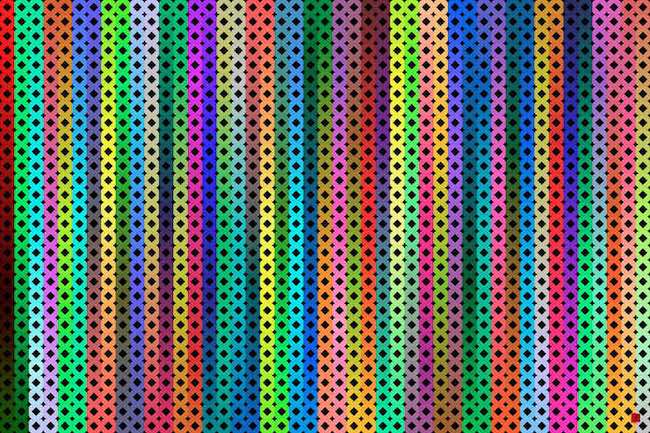La scoperta e l’approfondimento di culture lontane costituisce spesso la base di partenza, lo spunto elaborativo per tutto quel gruppo di artisti con forte indole sperimentatrice, che mostrano il bisogno di uscire da tutti gli schemi artistici tradizionali per seguire solo e unicamente il proprio istinto espressivo, delineando perciò innovazioni che si concretizzano in opere con una personalità ben definita. Al di là della scelta dello stile, o in alcuni casi dei diversi stili, attraverso cui manifestare questa poliedricità ciò che più di tutto salta agli occhi è la capacità di offrire interpretazioni sempre nuove e differenti di tutto ciò che nell’arte è stato già raccontato, detto, esplorato. La protagonista di oggi infonde carattere ed emozionalità a uno stile diversamente ritenuto rigoroso, proprio in virtù della morbidezza e del possibilismo che ha acquisito studiando e rielaborando tecniche diverse tra loro eppure in perfetta sintonia.
Intorno ai primi decenni del Novecento cominciò a prendere forma una forte ribellione nei confronti dell’arte tradizionale, al punto che un gruppo considerevole di artisti scelse di rinunciare completamente a tutto ciò che potesse essere riconducibile alla realtà esistente, poiché troppo limitante nei confronti di un gesto plastico il quale doveva avere una sua purezza espressiva epurata da ogni riferimento contingente. Nacque così l’Arte Astratta grazie a Vassily Kandinsky, ideatore dell’Astrattismo Lirico, in cui le emozioni facevano ancora parte dell’opera, soprattutto in virtù del forte legame con la musica che il maestro evocava nelle sue opere. Qualche anno più tardi però il Suprematismo Russo di Kasimir Malevic, volle implementare la necessità per il gesto plastico di distaccarsi non più solo dalla forma bensì anche dall’emozione che avrebbe in qualche modo contaminato la purezza dell’atto creativo fine a se stesso, per il quale era necessario ridurre la tavolozza cromatica ai soli colori primari; questa nuova visione essenziale dell’arte fu estremizzata dagli olandesi Piet Mondrian and Theo Van Doesburg, i quali nel loro De Stijl giunsero persino a escludere ogni forma geometrica che non fosse la linea, il quadrato o il rettangolo. Questa ricerca rigida e rigorosa li intrappolò però all’interno delle loro stesse regole che, al di là dell’impatto iniziale, non riuscirono a coinvolgere il pubblico a causa della ripetitività delle immagini e della mancanza totale di influenza emotiva. Questo ostacolo fu inizialmente superato dall’Astrattismo Geometrico italiano di Manlio Rho il quale introdusse tonalità più delicate, morbide, una schematicità meno regolare e più armonica, fatta di trasparenze e di una gamma di figure più ampia, aprendo di fatto la strada all’esplorazione sugli effetti ottici e sugli inganni visivi, pur sempre legati a una forte geometricità, dell’Op Art di cui Victor Vasarely fu il fondatore e uno dei principali esponenti. Facendo suoi gli studi sul colore del Puntinismo di Seurat e dell’impatto cromatico degli studi di Robert e Sonia Delaunay, fondatori del Cubsimo Orfico, egli costruì un messaggio visivo in cui la retina era impressionata e illusa dal gioco di luci e ombre coloristico e geometrico, sottolineando quanto in fondo tutta la realtà possa essere osservata da punti di vista diversi, e quanto l’espressione artistica sia in grado di condurre il fruitore ovunque il creativo desideri, anche in virtù di un sapiente utilizzo di tutte quelle sfumature di tinte e tonalità che nei movimenti di inizio secolo erano invece escluse. L’artista lussemburghese, ma da anni residente in Svizzera, Karin Monschauer, sembra costituire un punto di sintesi delle teorie di questi grandi maestri del Ventesimo secolo, ma anche un’evoluzione attraverso quella libertà espressiva assorbita e appresa durante gli studi di tecniche differenti che hanno contribuito alla sua formazione, in virtù della sua indole aperta alla trasversalità che le ha consentito di mescolare le sue esperienze per dar vita a qualcosa di nuovo.
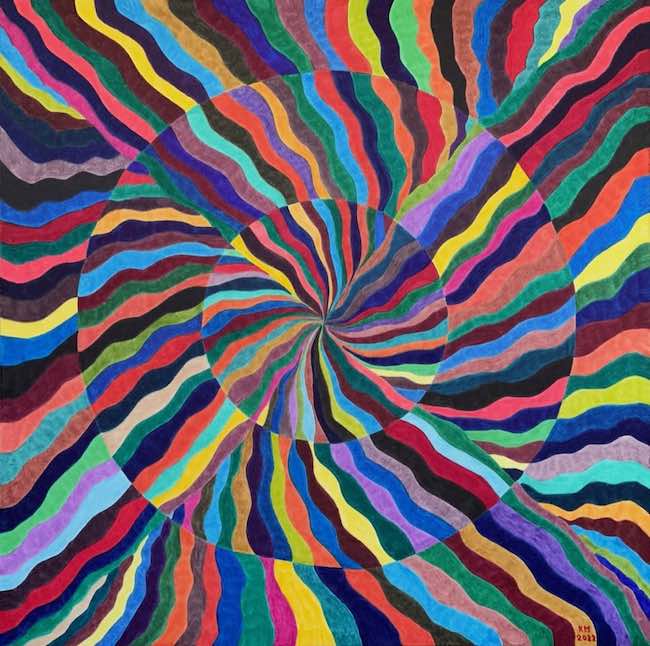
Parte dalla tecnica del ricamo, dalla quale si evince la poliedricità delle sue basi conoscitive e la capacità di mescolare la pura tecnica raqm, appartenente alla tradizione tessile araba, a una cromaticità forte e intensa dove le tonalità entrano in contatto tra loro esaltandosi reciprocamente; il suo impulso creativo però aveva bisogno di andare oltre, di salire di un gradino grazie al quale le sue opere hanno potuto trovare una doppia realizzazione creativa poiché avvalendosi di software grafici specifici ha scoperto il piacere di dar vita a immagini in cui tutto ciò a cui doveva lasciarsi andare era la sua fantasia e il suo impulso espressivo che si traduceva in coinvolgimento emotivo nell’osservatore.
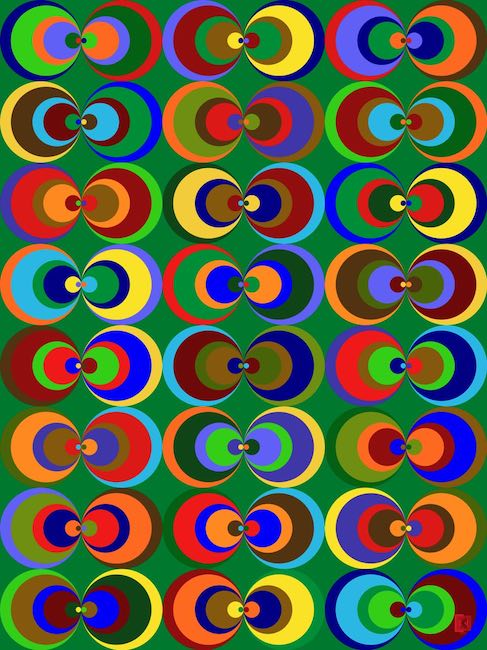
Dunque in un certo modo il ricamo è entrato nell’arte digitale tanto quanto l’arte digitale è entrata nel ricamo, entrambi con il denominatore comune di essere protagonisti di opere intense, enigmatiche a volte, piene di vitalità ma soprattutto geometricamente perfette al punto di apparire imperfette, proprio perché l’eccessivo rigore risulterebbe limitante alla Monschauer che vuole sovvertire le regole invitando il fruitore a sovvertirle a sua volta, entrando in un mondo fatto di possibilità e di personalizzazione in cui ciascuno può scegliere di seguire, o lasciarsi guidare, dalla propria linea emotiva, dal colore più affine al vero sé. Qualche anno fa il suo percorso creativo ha subìto un ulteriore passaggio, quello di andare a narrare l’attitudine alla geometricità optical anche attraverso un’azione più fisica, un approccio più plastico nei confronti della tela che però esce, ancora una volta, dallo schema tradizionale e tenta una dimensione inconsueta, quella dell’uso dei pennarelli colorati, i quali manifestano una loro forte personalità esaltata dalla ruvidità della superficie telata.
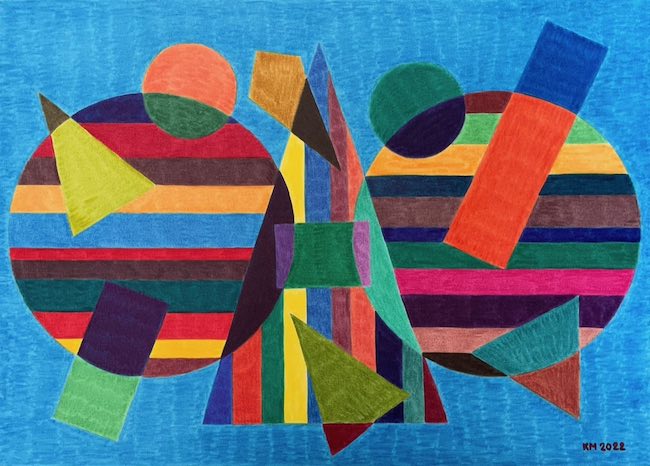
L’opera Magnetismo è realizzata con questa tecnica ed evidenzia l’influenza del Cubismo Orfico nella produzione di Karin Monschauer, laddove però, e in questo non tradisce la sua indole, viene inserita una variazione sul tema costituita dalle linee rette inserite all’interno di quelle tondeggianti; i colori sono vivaci, pieni, non esistono sfumature nella produzione dell’artista, piuttosto l’accostamento netto di tonalità che tendono a illuminarsi quando vicine ad altre che concettualmente potrebbero costituire il loro opposto dissonante. Il tratto dei pennarelli sembra compiere una sorta di macro Divisionismo che infonde all’opera un senso di forte plasticità, come se quelle brevi linee stessero a raccontare quanto di più possa esservi persino all’interno di un rigore apparente.
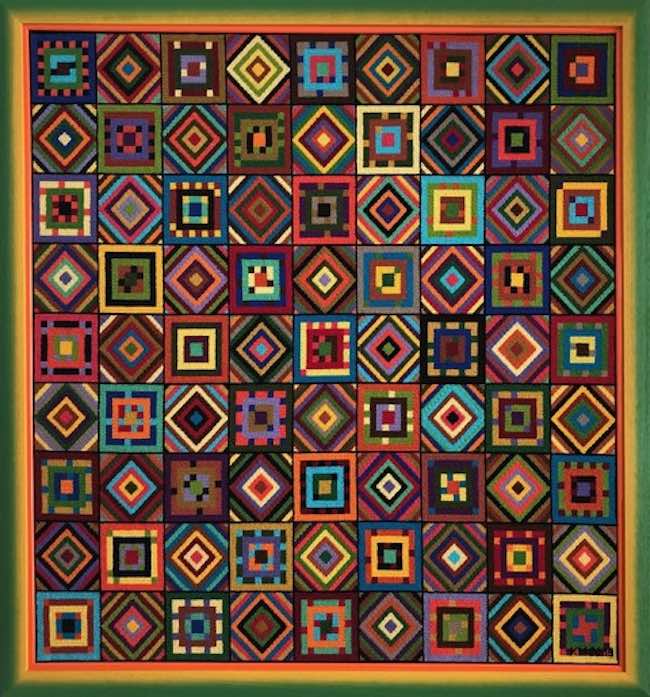
In Senza titolo del 2019 invece, Karin Monschauer riprende i temi tipici dei tessuti mediorientali personalizzandoli in maniera miniaturizzata senza rinunciare alla sua personalità espressiva che proprio dalla fascinazione ricevuta dall’osservazione di tale perfezione esecutiva ha tratto spunto di crescita; in questo caso la tecnica utilizzata è quella del mezzo punto, la cui base è stata realizzata attraverso i suoi programmi grafici e poi stampata su gobelin, un tipo di tessuto particolarmente utilizzato nell’arte del ricamo. L’effetto è optical, i colori infondono nell’osservatore una sensazione di tridimensionalità, catturandone l’attenzione fino a spingerlo a entrare con maggiore attenzione nel magico mondo geometrico dell’artista.
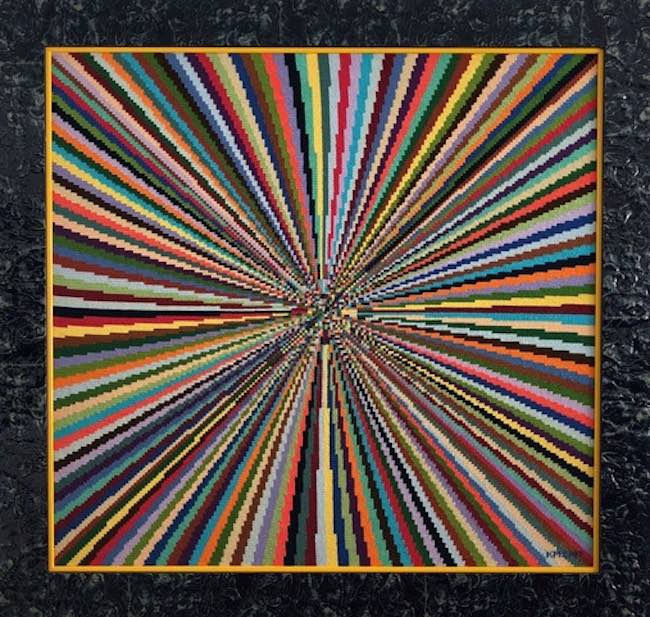
Persino più vicina all’Op Art è l’opera Schwarzt Lach, anch’essa realizzata a mezzo punto, dove non solo tutte le linee confluiscono nel centro della tela, ma il loro accostamento infonde la sensazione di un costante correre, muoversi in maniera caleidoscopica, comunicare le une con le altre fino a espandere la loro influenza cromatica. Ovviamente, nella produzione di questa poliedrica artista, non poteva mancare quello che è uno dei mezzi espressivi più congeniali ad assecondarsi alla sua infinita fantasia creativa, la Digital Art attraverso cui dà vita a opere intriganti, magnetiche, che attraggono l’attenzione verso il suo approccio alla vita aperto, flessibile nei confronti del modificarsi della realtà e sicuramente positivo proprio perché capace di lasciarsi andare e a farsi trascinare dall’energia dei colori.
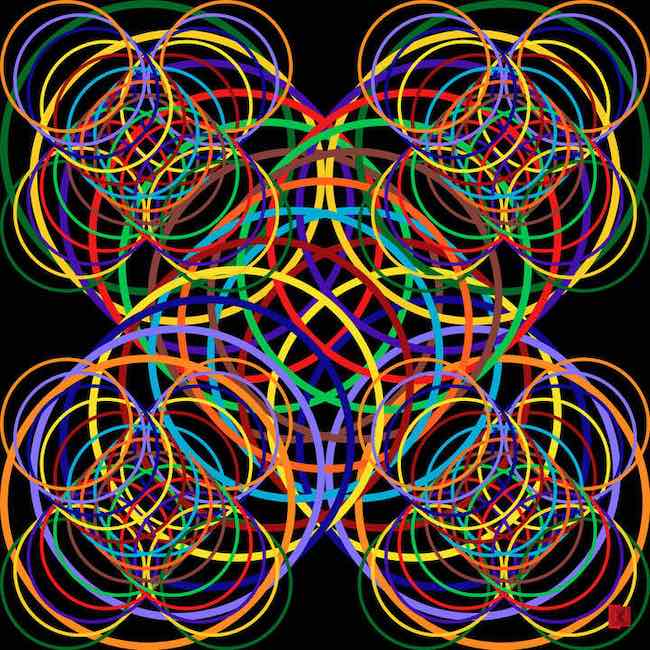
Nell’opera Rotazione infatti, Karin Monschauer evidenzia tutti i cicli, i corsi e ricorsi che si presentano nell’esistenza e che inevitabilmente entrano in contatto con altre esistenze, sottolineando quanto l’interazione sia fondamentale per un’evoluzione che altrimenti resterebbe solo e unicamente un percorso asettico, quasi fine a se stesso senza la presenza di altre persone grazie a cui fare e attingere esperienze nuove che possano modificare il colore di un singolo cammino.
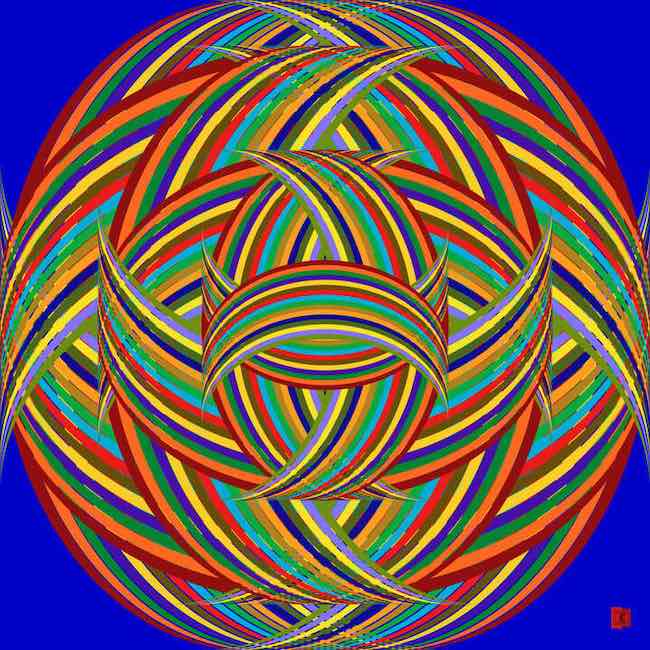
Karin Monschauer ha al suo attivo la partecipazione a moltissime mostre collettive in tutto il mondo – Svizzera, Italia, Usa, UK, Austria, Spagna, Francia, Belgio, Canada, Germania, Emirati Arabi Uniti – è stata insignita di diversi premi, è inserita in diversi cataloghi di arte contemporanea internazionale e una sua opera è esposta permanentemente presso l’European Art Museum, Frederiksvaerk Danimarca mentre altre quattro opere si trovano presso il Museo Le Bois Du Cazier, Charleroi Belgio.
KARIN MONSCHAUER-CONTATTI
Email: kar.mon@bluewin.ch
Sito web: www.karinmonschauer.ch
Facebook: www.facebook.com/KarMonArtista
Instagram: www.instagram.com/karinartista
Linkedin: https://www.linkedin.com/in/karin-monschauer
Embroideries, digital creations and unusual means to narrate the patterns of life in Karin Monschauer’s Geometric Abstractionism
The discovery and in-depth study of distant cultures often constitutes the starting point, the elaborative cue for that group of artists with a strong experimental nature, who show the need to break out of all traditional artistic schemes in order to follow their expressive instincts alone, thus outlining innovations that materialise in artworks with a well-defined personality. Beyond the choice of style, or in some cases of different styles, through which to manifest this versatility, what stands out most of all is the ability to offer ever new and different interpretations of everything that has already been told, said and explored in art. Today’s protagonist infuses character and emotionality to a style otherwise considered rigorous, precisely by virtue of the softness and possibilism she has acquired by studying and reworking techniques that are different yet perfectly in tune.
Around the first decades of the 20th century, a strong rebellion against traditional art began to take shape, to the point that a considerable group of artists chose to completely renounce everything that could be traced back to existing reality, as it was too limiting towards a plastic gesture that had to have its own expressive purity purged of all contingent references. Thus, Abstract Art was born thanks to Vassily Kandinsky, the creator of Lyrical Abstractionism, in which emotions were still part of the work, especially by virtue of the strong link with music that the master evoked in his canvases. A few years later, however, the Russian Suprematism of Kasimir Malevic, wanted to implement the necessity for the plastic gesture to detach itself no longer only from form but also from emotion that would somehow contaminate the purity of the creative act as an end in itself, for which it was necessary to reduce the colour palette to primary colours only; this new essential vision of art was taken to extremes by the Dutchmen Piet Mondrian and Theo Van Doesburg, who in their De Stijl even went so far as to exclude any geometric form other than the line, the square or the rectangle. However, this rigid and rigorous research trapped them within their own rules which, beyond their initial impact, failed to engage the public due to the repetitiveness of the images and the total lack of emotional influence. This obstacle was initially overcome by the Italian Geometric Abstractionism of Manlio Rho, who introduced more delicate, softer tones, a less regular and more harmonious schematicity, made of transparencies and a wider range of figures, paving the way for the exploration of optical effects and visual tricks, still linked to a strong geometricity, of Op Art of which Victor Vasarely was the founder and one of the main exponents. Making his own the studies on colour of Seurat‘s Pointillisme and the chromatic impact of the studies of Robert and Sonia Delaunay, founders of Orphic Cubism, he constructed a visual message in which the retina was impressed and deluded by the play of colouristic and geometric light and shadow, emphasising how all of reality can be observed from different points of view, and how artistic expression is capable of leading the viewer wherever the creative person wishes, also by virtue of a skilful use of all those shades and tones that were excluded in the movements of the early 20th century.
The Luxembourgian artist, but resident in Switzerland for many years, Karin Monschauer, seems to constitute a point of synthesis of the theories of these great masters of the 20th century, but also an evolution through that expressive freedom absorbed and learnt during her studies of different techniques that have contributed to her training, by virtue of her open-mindedness to transversality that has allowed her to mix her experiences to give life to something new. She started with the technique of embroidery, from which the multifaceted nature of her knowledge bases and her ability to mix the pure raqm technique, belonging to the Arab textile tradition, with a strong and intense chromaticity where the tones come into contact with each other enhancing each other, are evident; her creative impulse, however, needed to go further, to climb a step thanks to which her works were able to find a double creative realisation since, by using specific graphic software, she discovered the pleasure of giving life to images in which all she had to let go of was her imagination and expressive impulse that translated into emotional involvement in the observer. So in a way embroidery has entered digital art as much as digital art has entered embroidery, both with the common denominator of being the protagonists of intense artworks, enigmatic at times, full of vitality but above all geometrically perfect to the point of appearing imperfect, precisely because excessive rigour would be limiting for Monschauer, who wants to subvert the rules by inviting the viewer to subvert them in turn, entering a world of possibilities and personalisation in which everyone can choose to follow, or be guided by, their own emotional line, the colour most akin to their true self. A few years ago, her creative path underwent a further step, that of going to narrate the attitude of optical geometricity also through a more physical action, a more plastic approach to the canvas, which, however, once again breaks out of the traditional scheme and attempts an unusual dimension, that of the use of coloured felt-tip pens, which manifest their strong personality enhanced by the roughness of the canvas surface.
The artwork Magnetism is created with this technique and highlights the influence of Orphic Cubism in Karin Monschauer‘s production, where, however, and in this she does not betray her character, a variation on the theme is introducted, consisting of straight lines inserted within rounded ones; the colours are vivid, full, there are no nuances in the artist’s production, rather the sharp juxtaposition of tones that tend to brighten when close to others that conceptually might constitute their dissonant opposite. The strokes of the felt-tip pens seem to perform a kind of macro Divisionism that infuses the work with a sense of strong plasticity, as if those short lines were telling us how much more there can be even within apparent rigour. In Untitled 2019, on the other hand, Karin Monschauer takes up the typical themes of Middle-Eastern fabrics, personalising them in a miniaturised manner without renouncing her expressive personality, which has grown out of the fascination she has received from observing such perfection of execution. In this case, the technique used is that of half-stitch, the base of which was created using her graphic programmes and then printed on gobelin, a type of fabric particularly used in the art of embroidery. The effect is optical, the colours infuse the observer with a feeling of three-dimensionality, capturing his attention to the point of urging him to enter the artist’s magical geometric world with greater attention. Even closer to Op Art is the work Schwarzt Lach, also realised in half-stitch, where not only do all the lines converge in the centre of the canvas, but their juxtaposition infuses the sensation of a constant running, moving in a kaleidoscopic manner, communicating with one another to the point of expanding their chromatic influence. Obviously, in the production of this multifaceted artist, one of the means of expression most congenial to her infinite creative imagination could not be absent, Digital Art, through which she gives life to intriguing, magnetic artworks that draw attention to her open approach to life, flexible towards the modification of reality and certainly positive precisely because she is able to let herself go and be carried away by the energy of colours. In the work Rotation in fact, Karin Monschauer highlights all the cycles, the courses and recurrences that occur in existence and that inevitably come into contact with other existences, emphasising how interaction is fundamental for an evolution that would otherwise remain only an aseptic route, almost an end in itself without the presence of other people thanks to whom one can make and draw new experiences that can change the colour of a single path. Karin Monschauer has participated in many group exhibitions all over the world – Switzerland, Italy, USA, UK, Austria, Spain, France, Belgium, Canada, Germany, United Arab Emirates – has been awarded several prizes, is included in several international contemporary art catalogues and one of her works is on permanent display at the European Art Museum, Frederiksvaerk Denmark and four others are at Le Bois Du Cazier Museum, Charleroi Belgium.


